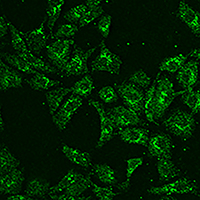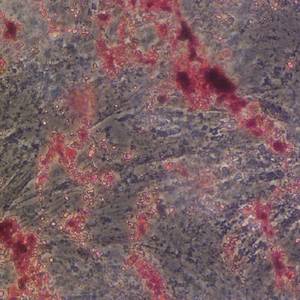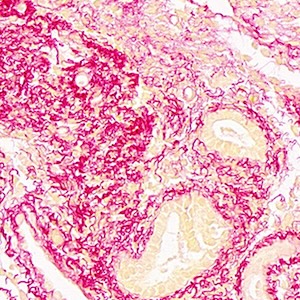Ciliary neurotrophic factor (CNTF) and its receptor (CNTFRα) signal through MAPK/ERK pathway in human prostate tissues: a morphological and biomolecular study

Submitted: 4 June 2020
Accepted: 15 September 2020
Published: 19 October 2020
Accepted: 15 September 2020
Abstract Views: 933
PDF: 595
HTML: 13
HTML: 13
Publisher's note
All claims expressed in this article are solely those of the authors and do not necessarily represent those of their affiliated organizations, or those of the publisher, the editors and the reviewers. Any product that may be evaluated in this article or claim that may be made by its manufacturer is not guaranteed or endorsed by the publisher.
All claims expressed in this article are solely those of the authors and do not necessarily represent those of their affiliated organizations, or those of the publisher, the editors and the reviewers. Any product that may be evaluated in this article or claim that may be made by its manufacturer is not guaranteed or endorsed by the publisher.
Similar Articles
- A. Makowiecka, A. Simiczyjew, D. Nowak, A.J. Mazur, Varying effects of EGF, HGF and TGFβ on formation of invadopodia and invasiveness of melanoma cell lines of different origin , European Journal of Histochemistry: Vol. 60 No. 4 (2016)
- D. Nowak, A. J. Mazur, A. Popow-Woźniak, A. Radwańska, H. G. Mannherz, M. Malicka-Błaszkiewicz, Subcellular distribution and expression of cofilin and ezrin in human colon adenocarcinoma cell lines with different metastatic potential , European Journal of Histochemistry: Vol. 54 No. 2 (2010)
- Azzurra Margiotta, Cinzia Progida, Oddmund Bakke, Cecilia Bucci, Characterization of the role of RILP in cell migration , European Journal of Histochemistry: Vol. 61 No. 2 (2017)
- S.A. Ferreira, J.L.A. Vasconcelos, R.C.W.C. Silva, C.L.B. Cavalcanti, C.L. Bezerra, M.J.B.M. Rêgo, E.I.C. Beltrão, Expression patterns of α2,3-Sialyltransferase I and α2,6-Sialyltransferase I in human cutaneous epithelial lesions , European Journal of Histochemistry: Vol. 57 No. 1 (2013)
- Ying Wang, Shifa Yuan, Jing Ma, Hong Liu, Lizhen Huang, Fengzhen Zhang, Substance P is overexpressed in cervical squamous cell carcinoma and promoted proliferation and invasion of cervical cancer cells in vitro , European Journal of Histochemistry: Vol. 67 No. 3 (2023)
- Xin Huang, Xuan Xu, Huajing Ke, Xiaolin Pan, Jiaoyu Ai, Ruyi Xie, Guilian Lan, Yang Hu, Yao Wu, microRNA-16-5p suppresses cell proliferation and angiogenesis in colorectal cancer by negatively regulating forkhead box K1 to block the PI3K/Akt/mTOR pathway , European Journal of Histochemistry: Vol. 66 No. 2 (2022)
- X.C. Xu, X. Abuduhadeer, W.B. Zhang, T. Li, H. Gao, Y.H. Wang, Knockdown of RAGE inhibits growth and invasion of gastric cancer cells , European Journal of Histochemistry: Vol. 57 No. 4 (2013)
- C. Bai, D. Wang, C. Li, D. Jin, C. Li, W. Guan, Y. Ma, Establishment and biological characteristics of a Jingning chicken embryonic fibroblast bank , European Journal of Histochemistry: Vol. 55 No. 1 (2011)
- J. Suchánková, S. Legartová, P. Sehnalová, S. Kozubek, S. Valente, D. Labella, A. Mai, C. Eckerich, F.O. Fackelmayer, D.V. Sorokin, E. Bartova, PRMT1 arginine methyltransferase accumulates in cytoplasmic bodies that respond to selective inhibition and DNA damage , European Journal of Histochemistry: Vol. 58 No. 2 (2014)
- Cuihong Jiang, Feng Liu , Shuai Xiao, Lili He, Wenqiong Wu, Qi Zhao, miR-29a-3p enhances the radiosensitivity of oral squamous cell carcinoma cells by inhibiting ADAM12 , European Journal of Histochemistry: Vol. 65 No. 3 (2021)
You may also start an advanced similarity search for this article.

 https://doi.org/10.4081/ejh.2020.3147
https://doi.org/10.4081/ejh.2020.3147















